

Tourism New Zealand right to change tack with new global campaign. OPINION: Perhaps it's a good thing that Tourism New Zealand's latest global campaign marks a shift away from the usual focus on our so-called pristine environment.

The launch of the latest instalment of the tourism board's 20-year-old "100% Pure New Zealand" campaign on Sunday coincides with yet further evidence that the country is anything but. Environmentalists 'alarmed' but Environment Canterbury says water survey results 'expected' Ninety-five per cent of Canterbury's monitored wells have nitrate levels worse or no better than those 10 years ago, according to Environment Canterbury's (ECan) latest annual survey.
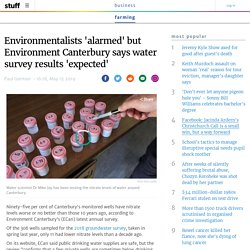
Of the 306 wells sampled for the 2018 groundwater survey, taken in spring last year, only 11 had lower nitrate levels than a decade ago. On its website, ECan said public drinking water supplies are safe, but the review "confirms that a few private wells are sometimes below drinking water standards". The survey showed samples from 7 per cent of the region's wells had nitrate concentrations above the maximum acceptable value (MAV) of 11.3 milligrams per litre of water, set in the national drinking water standards. READ MORE: * Cantabrians may have higher cancer risk from poor drinking water * Antibiotic-resistant bacteria discovered in two Canterbury rivers * Wrong questions being asked about Canterbury's water, professor says.
Why NZ shouldn't be waiting to tackle methane. A major new study shows the amount of methane in the atmosphere has been rising since 2007 – and it's not slowing down.
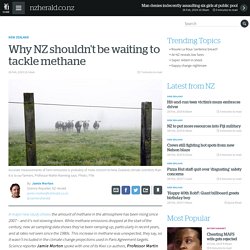
While methane emissions dropped at the start of the century, new air sampling data shows they've been ramping up, particularly in recent years, and at rates not seen since the 1980s. This increase in methane was unexpected, they say, so it wasn't included in the climate change projections used in Paris Agreement targets. Science reporter Jamie Morton spoke with one of its Kiwi co-authors, Professor Martin Manning, about what this means for New Zealand and its methane-heavy greenhouse gas inventory.
Your new paper found rising methane levels in the atmosphere could threaten the Paris Agreement's goal to keep temperature rise below 2C. NZ's role in the Malaysian plastics dumping ground. Thousands of tonnes of plastic that New Zealand used to send to China for recycling is now going to Malaysia, where illegal factories are burning and dumping the waste they can’t process.

Nita Blake-Persen travelled to Malaysia for Insight to investigate how the lives of local people and the environment are being affected. Koo Ze Quan (left) and Tan Siew Hoon stand on a mountain of plastic waste at an illegal factory in Jenjarom, Malaysia. Photo: RNZ / Nita Blake-Persen As night falls in Malaysia, plumes of toxic smoke begin to waft across the across the town of Jenjarom. Recycling centres struggling with increased volumes over summer. It's the hottest, busiest, smelliest time of year for recycling centres - and, one year after China stopped taking our plastics, some are still struggling to move thousands of tonnes of waste.
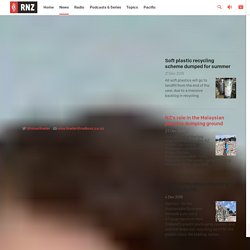
Bales of mixed plastic wait for export at Wellington's recycling facility at Seaview. Photo: RNZ / Nina Fowler On a recent morning, trucks could be seen rolling into Wellington's recycling facility at Seaview, laden with paper, cardboard, glass bottles and plastics. Waste management company says cheap tents should be banned as festival rubbish piles up.
A waste management company says the rubbish being left behind at festivals is getting out of hand.

Raglan's Xtreme Zero Waste was left with a massive clean-up job that included 600 discarded tents from the New Year season. It says companies that sell such cheap, disposable products should foot the bill for clean-up. Chief Entrepreneurial Officer of Xtreme Zero Waste, Cheryl Reynolds, says companies like The Warehouse need take some responsibility for the rubbish. She's asked the company to step-up and help fund the clean-up, and is calling for the sale of such tents to be banned. The Warehouse said in a statement that their tents are good quality and designed for multiple use and certainly are not designed to be used once and left behind. The things they left behind: Why campervans are costing our environment. A stream of overseas visitors has shown me how the NZ tourism industry needs to encourage more environmentally friendly behaviour, writes Jai Breitnauer.
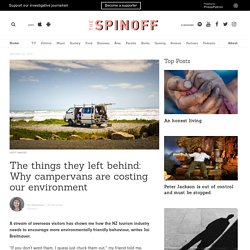
“If you don’t want them, I guess just chuck them out,” my friend told me, gesturing to the pile of stuff on the deck. “That’s what we would have had to do if you weren’t here.” In just three weeks of travelling our dear friends had accumulated a pile of now unwanted stuff to dispose of almost as big as when we last shifted house. Among the items they couldn’t take back to Europe with them included two garden chairs. Visitors have trashed one of New Zealand's most scenic lakes, Waikaremoana.
The dumping of vast amounts of rubbish by visitors to one of the country's most scenic lakes has shocked the iwi which manages it, and prompted calls to crack down on unruly behaviour in the area.

There have even been calls on social media for Lake Waikaremoana, in Te Urewera region, to be closed to visitors if things do not improve. But Ngāi Tūhoe says policing the area will do little to stop the disrespect and instead wants to appeal to people's common sense and decency to curb the issues. The lake, between Taupō and Gisborne, has become increasingly popular with tourists due to the Lake Waikaremoana Great Walk, one of the great walks of New Zealand.
In 2017, Ngāi Tūhoe took over management of the former national park from the Department of Conservation, as part of a Treaty settlement. Calls for initiatives to prevent construction boom from piling up waste. The Green Building Council is calling for more to be done to stop construction waste going to the dump as the building boom ramps up.
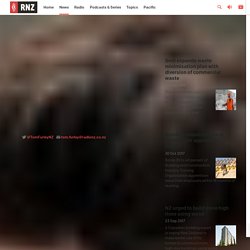
It is estimated up to 600,000 tonnes of building and demolition waste is going to landfill each year. Photo: RNZ / Teresa Cowie The Auckland Council estimates up to 600,000 tonnes of building and demolition waste is going to landfill each year. With the government's KiwiBuild plan set to add a further 50,000 homes to the city's workload over the next 10 years, the amount of waste is expected to skyrocket.
New Zealand Green Building Council chief executive Andrew Eagles, which represents 400 industry members, said per home you're looking at four to five tonnes of construction waste. Rising levels of 'black carbon' in Queen St heighten health risk for Aucklanders. Pedestrians and workers in Auckland's Queen St are being exposed to high levels of "black carbon", or ultra-fine carbon particles associated with a number of health problems.

Research by Auckland Council has found that after a decade of falling air pollution levels across the city, the downward trend has reversed, with concentrations on Queen St now on the rise again. In Queen St, the major source of the problem is higher diesel emissions from older buses, trucks, ferries and ships. Black carbon emissions are more than three times higher than Canadian cities and twice as high for concentrations in major European, UK and American cities, according to an article published by Auckland Council's research and evaluation unit. The research also found high levels of nitrogen dioxide pollution in Queen St, with peak concentrations close to Customs St. Black carbon, also known as soot, consists of very small ultra-fine carbon particles not much larger than viruses. NZTA contractors caught dumping rubble in Whangārei stream.
New Zealand Transport Agency contractors have been caught dumping rubble from road works into a stream that feeds into Whangārei Harbour. Road slabs thrown by a stream that feeds into Whangārei Harbour. Photo: MP Shane Reti The agency has been forced to clean up its act after a local MP raised the matter with Northland Regional Council. National MP for Whangarei Shane Reti was contacted by a constituent worried about a number of problems to do with roading near his house, which backs onto State Highway 1, about 15 minutes from the city. The resident showed the MP the Oakleigh River Bridge, which had two metre wide expansion strips cut out across it.
About 30 pieces of road had been cut off the highway and pushed straight into the stream underneath, Dr Reti said. Habitat loss, pollution drive significant drop in fish. Damning research into the populations of New Zealand's freshwater species indicate three-quarters are in decline. A research has found three-quarters of freshwater fish species in New Zealand are in decline. Photo: 123rf The author said central and local government have failed to protect our native fish.
The research, published by Victoria University of Wellington, looked at 25 different fish species over the past 47 years. Twenty of the fish studied as part of the research were natives and 15 of those were in decline. Habitat loss and pollution have been named as the main drivers of this decline. Rachel Stewart: Animal cruelty – a storm is coming.
Well, that's a turn up for the books. I've spent years so busy focusing on the dairy industry, I kind of missed the feedlot issue. I mean I knew they were out there, but not to the extent revealed by Checkpoint on Monday. Approximately 20,000 cattle in a mud-filled hell, being fattened like caged chooks on grain, wending their way slowly to slaughter. A while back I spent time at a falconry meet-up in Amarillo, Texas. In the days spent in the area hunting small game with raptors, I got my first up close and personal experience with an American feedlot in a small town called Hereford. Eaten contaminated eel? Tell Taranaki Regional Council. People who have eaten eels and freshwater fish from two South Taranaki streams contaminated by fire-fighting foam are being urged to come forward.
Taranaki Medical Officer of Health, Jonathan Jarman. Photo: RNZ / Robin Martin. What’s still worth recycling these days? How Greenpeace found an ally in Fonterra in fight against Mackenzie Basin dairy expansion. Last updated 18:20, July 4 2018 Tourists come to see wild tussock, not pasture in the South Island high country. Scientists Are Breeding Low-Emission Sheep - Agriculture, Innovation, News - NZEDGE. It's banned in other countries but New Zealand is using more toxic methyl bromide than ever. Council to get to root of logging debris problem after floods. ‘Your support brought me to tears’: Glen Herud on life after his Happy Cow story went viral. 100% Pure a 'marketing strategy ... not an environmental standard' Tourism Minister Kelvin Davis says work is being done on the strategy and the brand is evolving.
The 100% Pure campaign Photo: Supplied The New Zealand 100% Pure marketing slogan that has angered environmentalists is getting a shake-up. How many tourists are too many? - The Listener. Barcelona, famed for its architecture and history, is one of the world’s premier tourist destinations. But the city is in something of a cold war with the visitors who crowd its streets, throng around the iconic Sagrada Família and pack its beaches.
The city worked hard to attract tourists after hosting the 1992 Olympics, building cruise docks and cleaning up beaches and streets. It worked: these days, eight million people visit each year, accounting for about 14% of the city’s jobs and 10-12% of its economic activity. Anger after freedom camper cleans undies in drinking fountain. A North New Brighton resident is outraged after a freedom camper washed her underwear in a drinking fountain in the North Beach car park on February 24. Despite Nicky and another woman asked her to stop, the freedom camper continued. Sea of plastic threatens Grey district after storm.
Conservation - Animals/Pollution. Mining. Water. Planners grapple with New Zealand's 100 percent pure branding. Q&A: Is New Zealand really clean and green? It's true that, by some indicators, New Zealand enjoys better environmental health than many other developed nations. Some of that performance is down to pioneering regulation, such as the fisheries Quota Management System and the Resource Management Act.
However, much of it might also be described as a happy accident: New Zealand is, by global standards, sparsely populated, with an average of just 16.59 people per square kilometre in 2010 – less than half the OECD average and higher than only Australia, Iceland, Canada and Norway. Environmental pressures rising in New Zealand. 21/03/2017 - New Zealanders enjoy a high environmental quality of life and access to pristine wilderness.
However, New Zealand’s growth model, based largely on exploiting natural resources, is starting to show its environmental limits with increasing greenhouse gas emissions and water pollution, according to a new OECD report. While the country only accounts for a tiny share of global emissions, the OECD’s third Environmental Performance Review of New Zealand finds that intensive dairy farming, road transport and industry have pushed up gross GHG emissions by 23% since 1990. LRSS 24 How Clean and Green NZ Tourism. Potential effects. The growth and expanding influence of marine recreation and tourism is now well recognised in New Zealand. For example, NIWA noted (in 2012) that ecotourism is a growing industry in the nearshore waters around New Zealand and is already starting to expand into the Exclusive Economic Zone and extended continental shelf.
Similarly, a study commissioned by the Department of Conservation also identified the increasing importance of the coast and near-shore coastal waters of New Zealand as resources for recreation and tourism. Tourism, not just farming, has an impact on environment. Last updated 16:28, February 10 2016. 32% pure - NZ Geographic. Interview - Why we're not 100% pure. Pure deception? DOC money going to tourism not environment - conservationists. China warns NZ to retain 100% pure image on environment by Bernard Hickey - Newsroom Pro.
'100% Pure' myth. Untitled. New '100% Pure' campaign shows tourist drinking river water. Forest and Bird AGM 2011 cut. New Zealand’s Green Tourism Push Clashes With Realities. Print Page - 100% PURE “BULLSHIT” 100% Pure Fantasy? Living up to our brand. Election Policy Series: Passions high over natural assets - NZ Herald.